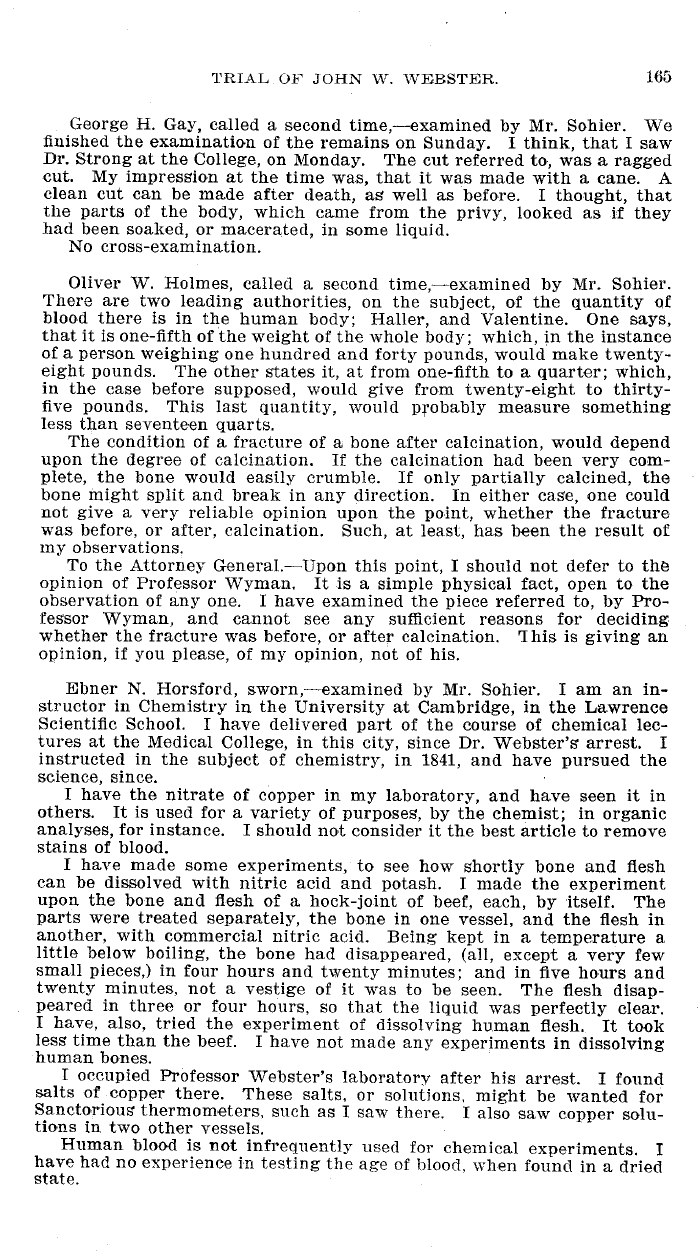|
TRIAL Oh JOHN W. W EBSTER. 165
George H. Gay, called a second time,-examined by Mr. Sohier. We
finished the examination of the remains on Sunday. I think, that I saw
Dr. Strong at the College, on Monday. The cut referred to, was a ragged
cut. My impression at the time was, that it was made with a cane. A
clean cut can be made after death, as well as before. I thought, that
the parts of the body, which came from the privy, looked as if they
had been soaked, or macerated, in some liquid.
No cross-examination.
Oliver W. Holmes, called a second time,-examined by Mr. Sohier.
Them are two leading authorities, on the subject, of the quantity of
blood there is in the human body; Haller, and Valentine. One says,
that it is one-fifth of the weight of the whole body; which, in the instance
of a person weighing one hundred and forty pounds, would make twenty-
eight pounds. The other states it, at from one-fifth to a quarter; which,
in the case before supposed, would give from twenty-eight to thirty-
five pounds. This last quantity, would probably measure something
less than seventeen quarts.
The condition of a fracture of a bone after calcination, would depend
upon the degree of calcination. If the calcination had been very com-
plete, the bone would easily crumble. If only partially calcined, the
bone might split and break in any direction. In either case, one could
not give a very reliable opinion upon the point, whether the fracture
was before, or after, calcination. Such, at least, has been the result of
my observations.
To the Attorney General.-Upon this point, I should not defer to the
opinion of Professor Wyman. It is a simple physical fact, open to the
observation of any one. I have examined the piece referred to, by Pro-
fessor Wyman, and cannot see any sufficient reasons for deciding
whether the fracture was before, or after calcination. 7 his is giving an
opinion, if you please, of my opinion, not of his.
Ebner N. Horsford, sworn,-examined by Mr. Sohier. I am an in-
structor in Chemistry in the University at Cambridge, in the Lawrence
Scientific School. I have delivered part of the course of chemical lec-
tures at the Medical College, in this city, since Dr. Webster's arrest. I
instructed in the subject of chemistry, in 1841, and have pursued the
science, since.
I have the nitrate of copper in my laboratory, and have seen it in
others. It is used for a variety of purposes, by the chemist; in organic
analyses, for instance. I should not consider it the best article to remove
stains of blood.
I have made some experiments, to see how shortly bone and flesh
can be dissolved with nitric acid and potash. I made the experiment
upon the bone and flesh of a hock-joint of beef, each, by itself. The
parts were treated separately, the bone in one vessel, and the flesh in
another, with commercial nitric acid. Being kept in a temperature a
little below boiling, the bone had disappeared, (all, except a very few
small pieces,) in four hours and twenty minutes; and in five hours and
twenty minutes, not a vestige of it was to be seen. The flesh disap-
peared in three or four hours, so that the liquid was perfectly clear.
I have, also, tried the experiment of dissolving human flesh. It took
less time than the beef. I have not made any experiments in dissolving
human bones.
I occupied Professor Webster's laboratory after his arrest. I found
salts of copper there. These salts, or solutions, might be wanted for
Sanctorious thermometers, such as I saw there. I also saw copper solu-
tions in two other vessels.
Human blood is not infrequently used for chemical experiments. I
have had no experience in testing the age of blood, when found in a dried
state.
|

